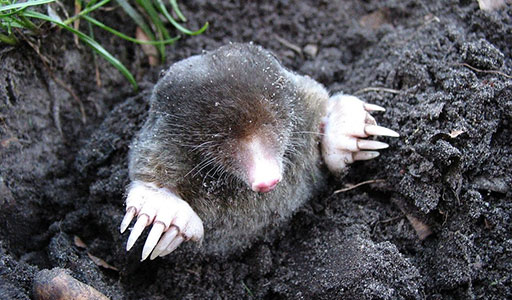Mole Control
Do you need to get rid of moles? We can help!

Mole Removal Strategies
Mole’s tunnels are an annoying yard problem for any prideful homeowner, but one that can easily be fixed with the help of Trutech’s mole removal experts. You can ensure that these critters are no longer looking for food in your yard by implementing Trutech mole control. Using our mole removal services will help you keep your yard looking as pristine as the rest of your home without lifting a finger.
Our humane mole traps and other mole control services are sure to solve your problems without weighing heavy on your animal-loving heart. Whether you are searching for mole control, trapping, or removal services, you can be confident that you are doing it in the most environmentally sensitive way. With each passing day, a mole can make 100 feet more of tunnels covering your yard, so don’t wait to reach out to Trutech for all of your wildlife removal needs.
Mole Problem

Signs a Mole is on Your Property
Did you look outside your house only to notice that the beautiful grass in your yard has been replaced by unsightly, uneven ground? This oddly deformed landscape is more than likely due to moles making tunnels just underneath the surface. Moles love to spend all of their time under the cold, wet, grass, looking for nutritious treats like earthworms and grubs. Since moles are very territorial, there are typically only 1 or 2 moles present on a property at once, however, a single mole can tunnel up to 100 feet within a single day causing a lot of lawn damage.

Dangers of Mole Infestation
Gardens, farmlands, grassy fields, and golf courses all suffer the effects of mole infestations. Since they excavate dirt near the surface, moles often create tunnels that deform landscapes. Additionally, the roots of grass and other plants become damaged as moles scoop away soil in search of food.
Humane Mole Removal & Control Strategies

Entry into property
Large populations are rare, as no more than three to five moles inhabit the same acre of land. Even so, they are capable of digging tunnels up to 100 feet long in a single day, and their voracious appetites mean they are constantly on the move in search of food. Well-kept lawns, golf courses, and public parks often have the perfect soil consistency and harbor plentiful populations of grubs and worms.

Trapping & Removal
The use of mole traps is a valid control option but requires the knowledge and expertise of wildlife professionals. Property owners facing mole problems should not hesitate to contact the mole removal personnel at Trutech, who can remove troublesome moles in the most efficient and humane ways possible.

Prevention & Exclusion
Keeping moles out of yards and gardens often entails modifying the landscape to make it inhospitable. This can be accomplished by removing access to food sources like worms, grubs, and larvae in the soil, or by compacting the soil with a heavy roller to make digging too difficult. Moles can be kept away from garden plots by installing fencing buried at least a foot into the ground, as well.
Frequently Asked Questions
The easiest way to identify mole damage to lawns is the presence of tracks and mounds. These are created as the pests tunnel just below the surface of the ground, overturning dirt with their powerful front feet. Their tracks can become so extensive that they intertwine like labyrinths, and dirt mounds found in yards are usually the entrances to burrows.
Gardens can be destroyed in no time by an infestation of moles, as a single pest can tunnel one foot per minute in the right soil conditions. While they don’t eat plants, moles do destroy their roots as they tunnel. Additionally, moles dig deeper into the ground for sleeping, mating, and riding out extreme weather. These can be as deep as 24 inches and cause sections of a yard to cave-in.
Moles can be extremely difficult to remove because they spend so much time underground and are unusually fast for their size. Common prevention tactics include castor oil-based repellents, annual lawn grub treatments, and planting certain bulb plants like garlic, shallots, and daffodils. However, these hardly work as long-term means of controlling mole damage. Trapping is the most effective way to get rid of infestations but is dangerous without a professional. To ensure that moles won’t do further damage to the yard, contact the skilled staff at Trutech.
Moles are known carriers of rabies, which is typically transmitted to humans through the saliva of infected animals. While moles tend to be shy, they will bite if they feel confused, threatened, or when they’re handled. However, people are more likely to contract a mole disease from the pests that live in their fur. Ticks and fleas can carry Lyme disease, Rocky Mountain spotted fever, anaplasmosis, and tularemia.
Moles prefer to live in cool, moist soil, and their diet consists of the insects found underground. As such, they rarely surface and instead spend most of their time in elaborate tunnel systems of their own creation. However, they may find themselves in basements on occasion.
Older homes with dirt floors are the most likely to have a mole in the basement. Additionally, moles may enter basements through gaps in building foundations or open cellar doors or windows. Property owners who encounter moles in basements should assume that the pest is lost or confused.
Since residential neighborhoods are often built on the loose soil that moles prefer to live in, property owners and the pests share many close encounters. Though they are more likely to be found in yards and gardens, moles may unintentionally find themselves in garages. Most often, this happens when the pests burrow underneath homes and get into garages through holes or gaps in the foundation.
However, moles may also wander into garages aboveground or be carried in by pets. Though moles do not typically enter garages on purpose, the spaces are damp, dark, and moist, which is the kind of environment these pests enjoy most. Still, they need access to soil and food to survive and do not usually stay in garages for long.
When moles enter homes, it’s typically by accident. Most infestations occur outdoors in gardens and yards. Since the pests are known for their tunneling behavior and live primarily in underground burrows, they generally need to stay outside in the soil. Nevertheless, residents may find moles in the house in basements and cellars from time to time. In most of these cases, the moles are invading older homes with dirt floors, cracks in the foundation, or gaps in the basement windows and panes.
Insects and grubs are moles’ main food sources. Digging through the ground builds up a large appetite, which means that moles are constantly on the hunt for worms, beetle larvae, and other insects found within the soil. Since moles’ favorite foods are typically attracted to gardens by roots or decaying plant matter, flower beds are excellent hunting grounds for the pests. Additionally, garden soil is generally loose and moist, which makes it easy for moles to tunnel through.
Many animals burrow and make different holes in your hard. Burrowing animals include voles, gophers, and chipmunks. Raccoons, skunks, and opossums also can dig up your yard.


